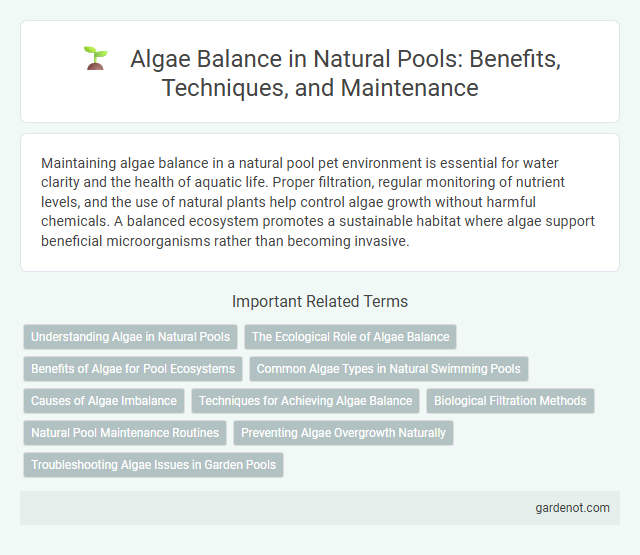Maintaining algae balance in a natural pool pet environment is essential for water clarity and the health of aquatic life. Proper filtration, regular monitoring of nutrient levels, and the use of natural plants help control algae growth without harmful chemicals. A balanced ecosystem promotes a sustainable habitat where algae support beneficial microorganisms rather than becoming invasive.
Understanding Algae in Natural Pools
Algae in natural pools play a crucial role in maintaining ecological balance by producing oxygen and providing habitat for beneficial microorganisms. Managing algae levels ensures clear water and prevents excessive growth that can disrupt the pool's ecosystem. Understanding algae species and their growth patterns helps optimize filtration and natural cleaning processes in the pool.
The Ecological Role of Algae Balance
Algae balance plays a crucial ecological role in natural pools by maintaining water clarity and supporting aquatic life through oxygen production. Proper algae levels facilitate nutrient cycling, preventing excessive growth that can disrupt the ecosystem and promote harmful algal blooms. This balance creates a stable habitat for microorganisms and plants, enhancing biodiversity and water quality in natural swimming environments.
Benefits of Algae for Pool Ecosystems
Algae play a crucial role in maintaining the ecological balance of natural pools by producing oxygen through photosynthesis, which supports aquatic life and enhances water quality. They act as a natural filter by absorbing nutrients and pollutants, preventing the growth of harmful bacteria and maintaining clear water. Their presence fosters biodiversity by providing habitat and food for beneficial microorganisms and aquatic species, contributing to a self-sustaining pool ecosystem.
Common Algae Types in Natural Swimming Pools
Common algae types in natural swimming pools include green algae, filamentous algae, and blue-green algae, each affecting water clarity and ecosystem balance differently. Green algae often cause cloudy water but support aquatic life, while filamentous algae form visible mats that can obstruct swimming areas. Blue-green algae, or cyanobacteria, pose health risks and require careful monitoring to maintain algae balance in natural pools.
Causes of Algae Imbalance
Algae imbalance in a natural pool often results from excess nutrients like nitrogen and phosphorus, which promote rapid algae growth. Insufficient circulation and inadequate filtration reduce water movement, creating stagnant areas where algae thrive. Sunlight exposure and fluctuating water temperatures also contribute to the proliferation of algae in natural swimming pools.
Techniques for Achieving Algae Balance
Maintaining algae balance in a natural pool requires a combination of effective filtration systems, controlled nutrient levels, and sufficient aquatic plant coverage to compete with algae for sunlight and nutrients. Regular monitoring of water parameters such as nitrate and phosphate concentrations helps prevent algae overgrowth by enabling timely adjustments to water circulation and biological filtration. Incorporating beneficial bacteria and using natural skimmers further supports the ecological equilibrium, promoting clear, healthy water without chemical additives.
Biological Filtration Methods
Biological filtration methods in natural pools use beneficial bacteria and aquatic plants to maintain algae balance by breaking down nutrients that algae need to thrive. These systems rely on biofilters and plant root zones to filter organic matter and reduce excess nitrogen and phosphorus. Maintaining a healthy equilibrium through biological filtration minimizes chemical use and supports a sustainable, clear natural pool environment.
Natural Pool Maintenance Routines
Maintaining algae balance in a natural pool requires consistent monitoring of water quality parameters such as pH, nutrient levels, and sunlight exposure. Implementing biological filtration through aquatic plants and ensuring regular water circulation helps prevent excessive algae growth while supporting a healthy ecosystem. Routine removal of organic debris and avoiding chemical treatments preserve the natural pool's ecological stability and water clarity.
Preventing Algae Overgrowth Naturally
Maintaining a natural pool's algae balance requires controlling nutrient levels and optimizing natural filtration through aquatic plants that absorb excess nitrogen and phosphorus. Introducing beneficial microorganisms accelerates organic matter decomposition, preventing nutrient buildup and algae overgrowth. Regularly adjusting water circulation ensures oxygen distribution, inhibiting algae proliferation without relying on chemicals.
Troubleshooting Algae Issues in Garden Pools
Maintaining algae balance in natural garden pools requires careful monitoring of nutrient levels and water circulation to prevent excessive growth. Troubleshooting algae issues often involves identifying sources of nutrient pollution such as decaying organic matter or runoff containing fertilizers. Implementing UV clarifiers, adding beneficial aquatic plants, and promoting natural filtration can effectively control algae proliferation and preserve water clarity.
Algae balance Infographic

 gardenot.com
gardenot.com